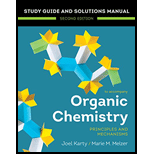
EBK ORGANIC CHEMISTRY: PRINCIPLES AND M
2nd Edition
ISBN: 9780393543971
Author: KARTY
Publisher: VST
expand_more
expand_more
format_list_bulleted
Concept explainers
Question
Chapter A, Problem A.36P
Interpretation Introduction
(a)
Interpretation:
For the given structure the IUPAC name is to be written.
Concept introduction:
Interpretation Introduction
(b)
Interpretation:
For the given structure the IUPAC name is to be written.
Concept introduction:
Interpretation Introduction
(c)
Interpretation:
For the given structure the IUPAC name is to be written.
Concept introduction:
Interpretation Introduction
(d)
Interpretation:
For the given structure the IUPAC name is to be written.
Concept introduction:
Expert Solution & Answer
Want to see the full answer?
Check out a sample textbook solution
Students have asked these similar questions
Poly(ethylene adipate) is a biodegradable polyester (shown below). Identify the type of polymerization process used in the production of this polymer.
Polymers may be composed of thousands of monomers. draw two repeat units(dimer) of the polymer formed in this reaction. assume there are hydrogen atoms on the two ends of the dimer. ignore inorganic byproducts please
Draw the product of the reaction shown below. Use a dash or wedge bond to indicate stereochemistry of substituents on asymmetric centers, Ignore inorganic byproducts
Chapter A Solutions
EBK ORGANIC CHEMISTRY: PRINCIPLES AND M
Ch. A - Prob. A.1PCh. A - Prob. A.2PCh. A - Prob. A.3PCh. A - Prob. A.4PCh. A - Prob. A.5PCh. A - Prob. A.6PCh. A - Prob. A.7PCh. A - Prob. A.8PCh. A - Prob. A.9PCh. A - Prob. A.10P
Ch. A - Prob. A.11PCh. A - Prob. A.12PCh. A - Prob. A.13PCh. A - Prob. A.14PCh. A - Prob. A.15PCh. A - Prob. A.16PCh. A - Prob. A.17PCh. A - Prob. A.18PCh. A - Prob. A.19PCh. A - Prob. A.20PCh. A - Prob. A.21PCh. A - Prob. A.22PCh. A - Prob. A.23PCh. A - Prob. A.24PCh. A - Prob. A.25PCh. A - Prob. A.26PCh. A - Prob. A.27PCh. A - Prob. A.28PCh. A - Prob. A.29PCh. A - Prob. A.30PCh. A - Prob. A.31PCh. A - Prob. A.32PCh. A - Prob. A.33PCh. A - Prob. A.34PCh. A - Prob. A.35PCh. A - Prob. A.36PCh. A - Prob. A.37PCh. A - Prob. A.38PCh. A - Prob. A.39PCh. A - Prob. A.40PCh. A - Prob. A.41PCh. A - Prob. A.42PCh. A - Prob. A.43PCh. A - Prob. A.44PCh. A - Prob. A.45PCh. A - Prob. A.46P
Knowledge Booster
Learn more about
Need a deep-dive on the concept behind this application? Look no further. Learn more about this topic, chemistry and related others by exploring similar questions and additional content below.Similar questions
- Draw the product of this reaction please. Ignore inorganic byproductsarrow_forwardOne of the pi molecular orbitals of 1,3-butadiene (CH2=CHCH=CH2) is shown below. Please identify the number of nodal planes perpendicular to the bonding axisarrow_forwardDraw the monomers required to synthesize this condensation polymer please.arrow_forward
- Provide the correct systematic name for the compound shown here. Please take into account the keyboard options belowarrow_forwardcurved arrows are used to illustrate the flow of electrons. using the provided starting and product structures, draw the curved electron-pushing arrows for the following reaction or mechanistic step(s)arrow_forwardIdentify the 'cartoon' drawing of the acceptor orbital in the first mechanistic step of an electrophilic addition reaction of butadiene with HBr. Pleasearrow_forward
- H- H H H H H H Identify and select all structures below that represent a constitutional isomer(s) of the compound shown above. H- H H H A. H H H H-C CI H H D. H H H H H H C C -H H C C H H H H B. H CI H H- C C H H H H E. H CI H C.arrow_forwardWhy doesn't this carry on to form a ring by deprotonating the alpha carbon and the negatively-charged carbon attacking the C=O?arrow_forward6. A solution (0.0004 M) of Fe(S2CNEt2)3 (see the structural drawing below) in chloroform has absorption bands at: 350 nm (absorbance A = 2.34); 514 nm(absorbance A = 0.0532); Calculate the molar absorptivity values for these bands. Comment on their possible nature (charge transfer transitions or d-d S N- transitions?). (4 points)arrow_forward
- What is the mechanism for this?arrow_forwardFor questions 1-4, consider the following complexes: [Co(CN)6], [COC14]², [Cr(H2O)6]²+ 4. Room temperature (20°C) measurement of molar magnetic susceptibility (Xm) for Fe(NH4)2(SO4)2×6H2O is 1.1888 x 102 cgs (Gaussian units). Calculate effective magnetic moment and provide a number of unpaired electrons for the iron ion. Use this number to rationalize the coordination geometry around iron center. (4 points)arrow_forward7. Describe the expected 31P and 19F (where applicable) NMR spectral patterns for the following compounds (indicate number of signals and their splitting patterns). a) tetraphenyldiphosphine Ph Ph P-P Ph Ph Ph Ph ' b) tetraphenyldiphosphine monoxide P-P-Ph Ph (2 points) (2 points c) tetrafluorophosphonium hexafluorophosphate [PF4]*[PF6]¯ (4 points)arrow_forward
arrow_back_ios
SEE MORE QUESTIONS
arrow_forward_ios
Recommended textbooks for you

Nomenclature: Crash Course Chemistry #44; Author: CrashCourse;https://www.youtube.com/watch?v=U7wavimfNFE;License: Standard YouTube License, CC-BY